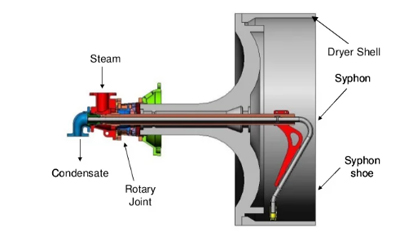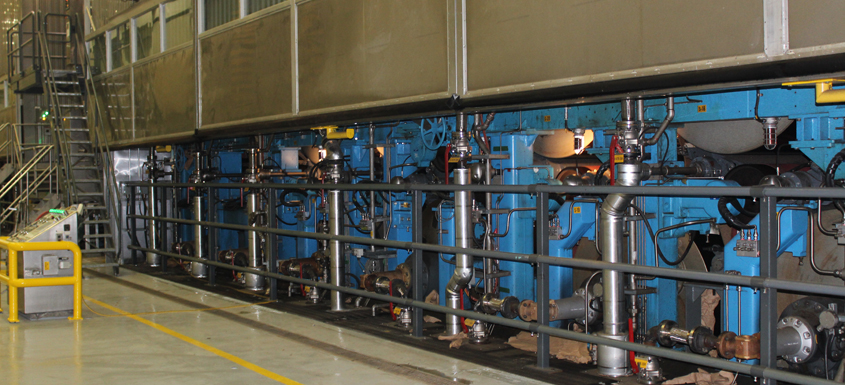Paper dryers can experience periodic problems with flooding. A flooded dryer is one that has an excessive amount of condensate in it.
Flooding occurs when condensate is being evacuated from the dryer at a rate that is less than the rate at which steam is condensing in the dryer. A dryer begins to recover from a flooded condition when the evacuation rate exceeds the condensing rate. Here are some common mechanical problems that can cause paper drying flooding.

- Syphon shoe design – Some older design syphon shoes did not have a "scoop" contour. These syphon shoes require higher differential pressures and they are more susceptible to dryer flooding.
- Syphon shoe installed backwards – Scoop-style stationary syphons must face opposite running direction of the dryer. If they do not, they are inefficient in removing condensate.
- Eroded syphon shoe – Syphon shoes can erode over time. If the tip of the shoe is eroded, the shoe becomes ineffective in removing condensate and dryer flooding results.
- Loss of syphon shoe clearance – If the opening under the tip of a rotating syphon is closed off, the dryer will not drain. The clearance can be closed off if the shoe is embedded into the shell or if the rotary syphon spacers were not installed.
- Internal joint leakage -Some styles of steam joints can have leakage inside the joint, between the steam supply chamber and the condensate discharge chamber. This can cause dryer flooding, even though there is sufficient differential pressure across the joint and the amount of blow through is high.
- Broken syphons - If either the horizontal or vertical syphon pipe breaks inside the dryer, the syphon will not drain the condensate. Syphon breakage can be caused by corrosion, loose balance weights, shifting dryer bars, and contact between the internal dryer shell and the stationary syphon.
- Undersized syphon pipes - The internal syphon piping (vertical and horizontal pipes and shoe) may be too small for the current operating conditions (dryer speed, condensing load, and pressure). If so, higher operating differential pressures will be required, perhaps resulting in undersized steam piping.
- Syphon elbow erosion - If the internal dryer syphon elbow is eroded, blow-through steam will by-pass the syphon shoe and the dryer will not drain. Cast iron and ductile iron elbows are particularly susceptible to erosion. It may be difficult to see the erosion during dryer internal inspections. A ball peen hammer can be used to “sound out” the elbows during internal inspection.
- Piping obstructions - Occasionally, debris is left in the dryer piping (pipe plugs, cans, rags, etc.). This can greatly reduce the flow capacity and cause dryer flooding.
- Improperly valved-off dryers - If a dryer is to be valved-off to take it out of service, positive shut-off must be maintained for both the steam and condensate lines. This can be done by disconnecting the flex hoses to the joint, putting blank plates between pipe flanges, or having two isolation valves with an open vent line between them, for both the steam and the condensate lines.
Kandi Hagenbuch is Digital Content Specialist at Kadant
Source: Kadant













